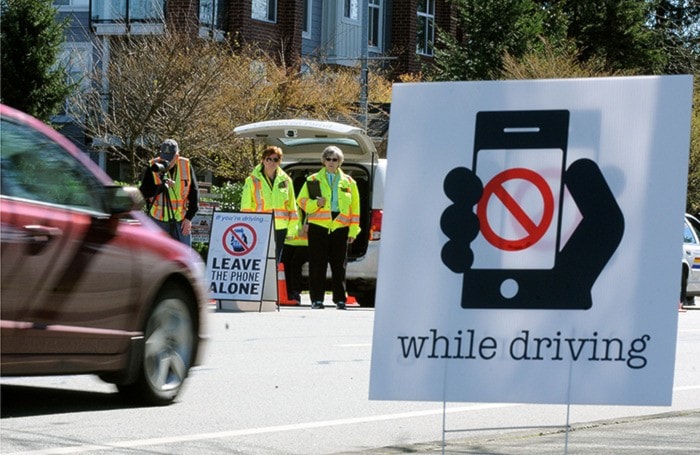Motorists must have been reading the Ridge Meadows Mounties e-mail on last Thursday afternoon.
During the first hour of a Speed Watch set up on Harris Road across from Pitt Meadows elementary, drivers were behaving themselves as they slowed down to go through a school zone, while keeping their seat belts on and their cellphones off.
Speed Watch volunteers, along with RCMP community policing officer Cpl. Tony Vanags was there, just in case they didn’t.
“Overall, I would say people are really getting the message, but there a few who are not,” Vanags said as cars crept by.
The check stop was part of Distracted Driving Awareness Month, aimed at getting motorists to focus on the road and not on their cellphones.

According to ICBC, people on cellphones or otherwise distracted caused 25 per cent of all fatal crashes every year in B.C. That works out to about 81 people killed a year by motorists who are texting, talking or surfing on their phones.
That means more people are now dying from people driving while on smart phones compared to those killed by drunks behind the wheel, according to RCMP.
B.C., however, takes the offence of distracted driving fairly lightly when compared to the rest of Canada.
The fine is only $167 for talking on a phone while driving. If you text or e-mail while behind the wheel, you could get three demerit points added to your driving record.
According to the Canadian Auto Association, only two other provinces have lower fines: Quebec, starting at $115; and Newfoundland, starting at $100.
In Ontario, drivers can be fined between $300 and $1,000, while the fine in Alberta is $287.
Joan Streifel, with Speed Watch, said since her group reorganized a few years ago that motorists are recognizing the vans and warning signs when they see them on the street.
“They seem to be getting the message, definitely to do with speeds,” said Streifel.
“If they see us, they really slow down. They seem to have respect now for us.”
While March is intended to focus on mobile-using motorists, Maple Ridge council recently approved spending up $150,000 to buy 10 new speed-reader boards (added to four already existing) to allow the city to follow a “three-strikes-and-you’re out” approach to dealing with lead-foot motorists.
The first strike is when a motorist zooms by a speed limit sign, doing more than the speed limit.
The second strike would be zooming by one of the electronic reader boards, which would start flashing the posted speed limit, rather than the vehicle’s actual speed.
The third strike would be speeding past a police officer’s radar speed gun, earning a ticket.
However, one twist in the strategy is that police may or may not be farther down the road at that particular time. Whether a driver wants to keep speeding depends on whether he or she feels lucky that day.
According to head of Ridge Meadows RCMP traffic services Sgt. Bruce McCowan, the tactic works because “by the time a driver comes into the police speed enforcement, or the strike-three zone, the majority have slowed down and not many are charged for speeding.”
However, the staff report notes that without police at the other end, speed reader boards soon lose their effectiveness.
An ICBC study of speeding on Dewdney Trunk Road and 205th Street found that a speed reader board reduced speeds by only one km/h over a three-month period.
McCowan said speeding remains a problem on Lougheed Highway, for instance on Telosky Hill, just west of Kanaka Way.
People also like to get on the gas and go over the 80 km/h Lougheed Highway speed limit in the east part of the city, as well, between 240th and 272nd streets.
Lougheed Highway, all the way through Pitt Meadows, is also a problem area.
The other east-west corridor, Dewdney Trunk Road, also collects its share of people who want to go fast, particularly between 207th and 222nd streets, and from 240th Street east to Wilson Road.
The only north-south corridor where police say speeding is a problem is 232nd Street between Dewdney Trunk Road and Abernethy Way.
In 2015, Ridge Meadows RCMP charged an all-time high number of drivers with excessive speeding.
For example, 322 drivers were charged for driving more than 40 kilometres over the speed limit last year, (compared to 114 in 2014) and so far in 2016, 84 drivers have been charged. Drivers who exceed the speed limit by 40 km/h, also have their vehicles seized for a week and have to find their own way home.
Ten people died in 2015 on Maple Ridge and Pitt Meadows roads.
McCowan said police haven’t increased enforcement, but police are concentrating on high-crash areas and the leading causes of crashes – speeding, impaired driving and distracted driving.
Since the focused approach was adopted, there’s been a 16-per-cent decrease (2014 to 2015) in collisions at the high-crash intersections.
